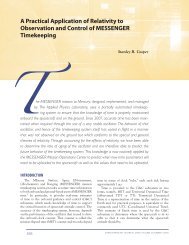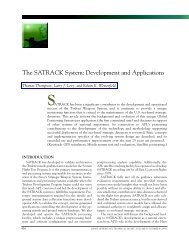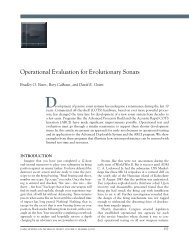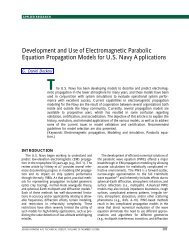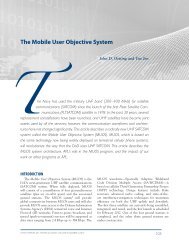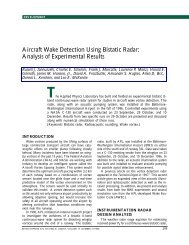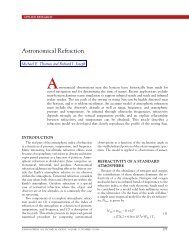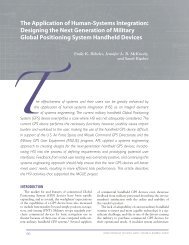Modern Electronic Packaging Technology - Johns Hopkins APL ...
Modern Electronic Packaging Technology - Johns Hopkins APL ...
Modern Electronic Packaging Technology - Johns Hopkins APL ...
Create successful ePaper yourself
Turn your PDF publications into a flip-book with our unique Google optimized e-Paper software.
A printed circuit board is normally fabricated as an<br />
epoxy or polyimide fiberglass composite structure. It<br />
contains layers of copper traces on the surface and<br />
within the structure that are connected by metallized<br />
vias. Components are soldered to the surface and in<br />
through-holes. The materials and processes used at<br />
<strong>APL</strong> to fabricate substrates were developed to maximize<br />
electrical performance within cost and durability<br />
constraints. For example, the coefficients of in-plane<br />
thermal expansion of the composite and the copper<br />
traces are similar, minimizing substrate warpage during<br />
soldering and temperature cycling.<br />
Most vias extend through the entire thickness of the<br />
board, connecting any of the inner layers of the board<br />
to the surface. This configuration limits the routing of<br />
traces to the space between the vias. Blind and buried<br />
vias (i.e., vias that do not extend through the board)<br />
avoid this constraint but significantly increase the price<br />
of the board. A blind via extends from the surface of<br />
the substrate to a dead end at an inner layer; a buried<br />
via begins and ends on inner layers of the substrate.<br />
These special types of vias ease routing by limiting via<br />
length, allowing a trace to be routed above or below<br />
the area that would otherwise be occupied by the via.<br />
Although boards with these special types of vias are<br />
costly, they may still be more economical than the use<br />
of silicon or ceramic alternatives.<br />
Several variations to the traditional board offer alternative<br />
packaging options. New advances in ceramic<br />
substrates and boards allow passive resistors and capacitors<br />
to be buried in the substrate, which frees up additional<br />
space on the surface of the substrate. However,<br />
these built-in components do not have the range of<br />
values, tolerances, or performance available from discrete<br />
components.<br />
For high-frequency circuits that are particularly sensitive<br />
to capacitive coupling, the circuit substrate must<br />
often be constructed with a special, uniform dielectric<br />
material such as Duroid. The Duroid dielectric is a<br />
mixture of alumina powder and polytetrafluoroethylene<br />
that has a controlled, dielectric constant which<br />
varies little across the substrate. The copper traces on<br />
these boards are laid out using special rules to optimize<br />
circuit performance and minimize reflections. These<br />
rules include careful grounding, rounding the corners<br />
of traces, and choosing trace layouts with matched<br />
impedance to tune the circuit.<br />
Circuit substrate technology has moved from the<br />
traditional flat, rigid boards to flexible substrates and<br />
rigid-flex boards, a hybrid of the rigid and flexible technologies.<br />
Flexible substrates are made from sheets of<br />
polyimide (e.g., Kapton), laminated with copper foil to<br />
form traces. These may have several layers like rigid<br />
substrates. Flexible substrates permit rolling and folding<br />
to fit the space available, which has many advantages<br />
in the packaging of electronics in constrained areas<br />
MODERN ELECTRONIC PACKAGING TECHNOLOGY<br />
or in areas with odd shapes. It also permits the circuit<br />
to be assembled and tested flat, then folded into the<br />
available space. Many consumer electronic products<br />
such as cameras and watches contain such flexible substrates.<br />
Rigid-flex boards combine the advantages of both<br />
flexible and rigid substrates. Such composite structures<br />
use flexible segments to connect rigid portions of the<br />
circuit board (Fig. 8). One common application of<br />
rigid-flex boards is for motherboards. Before rigid-flex<br />
technology, the motherboard was connected to the<br />
external connectors using up to hundreds of discrete<br />
wires. This manual wiring process was time-consuming<br />
and error prone. By substituting a segment of flex<br />
substrate for the discrete wires, the wiring process is<br />
reduced to soldering the connector pins onto a board,<br />
thereby eliminating problematic hand wiring.<br />
CHASSIS-LEVEL PACKAGING<br />
Chassis-level packaging connects the circuit boards<br />
and mounts them into a chassis, forming a system or<br />
subsystem. For many systems (e.g., personal computers),<br />
this is the level of packaging seen by the user. In<br />
satellites, this chassis-level package is connected to a<br />
structural frame and electrically connected to other<br />
chassis having different functions. The design phase of<br />
chassis packaging has similar mechanical, thermal, and<br />
materials considerations found in device and circuit<br />
board packaging. For <strong>APL</strong>’s typical spacecraft and for<br />
most avionics applications, card guides hold the circuit<br />
boards by their sides in an aluminum housing, with a<br />
motherboard connecting the different boards (Fig. 9).<br />
This layout usually reflects the system partitioning to<br />
facilitate testing. Card guides ease insertion and removal<br />
of circuit boards while increasing heat dissipation. To<br />
facilitate electrical testing, extender cards can be used<br />
with this layout to probe individual boards while operating<br />
the entire box.<br />
Traditionally, systems engineering allots each subsystem<br />
or major function its own chassis. Each chassis<br />
would be connected to the system through a power line<br />
and data bus and contain its own power supply and data<br />
transfer functions. To conserve space, reduce costs, and<br />
improve reliability, many newer systems are being packaged<br />
into a common chassis. These common chassis<br />
contain circuit boards for several electronic functions,<br />
located in one housing, on a common motherboard.<br />
By combining many cards and functions into one<br />
housing, redundant power supplies, data transfer<br />
circuits, and harnesses are eliminated. This increases<br />
packaging density and potentially improves system reliability.<br />
Although this packaging concept has advantages,<br />
it complicates testing, heat removal, and system<br />
integration. Because of electromagnetic interference, it<br />
JOHNS HOPKINS <strong>APL</strong> TECHNICAL DIGEST, VOLUME 20, NUMBER 1 (1999) 31




